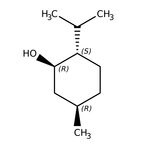Search Thermo Fisher Scientific
Thermo Scientific Chemicals
DL-mentol, +98 %, Thermo Scientific Chemicals
Número de catálogo: A18098.18
50 g, Each



Thermo Scientific Chemicals
DL-mentol, +98 %, Thermo Scientific Chemicals
Número de catálogo: A18098.18
50 g, Each
Cantidad
Número de catálogo: A18098.18
también denominado A18098-18
Precio (EUR)
22,14 Precio en línea
24,60
Each
Cantidad
-
Identificadores químicos
CAS
89-78-1
IUPAC Name
(1R,2S,5R)-5-methyl-2-(propan-2-yl)cyclohexan-1-ol
Molecular Formula
C10H20O
InChI Key
NOOLISFMXDJSKH-KXUCPTDWSA-N
SMILES
CC(C)[C@@H]1CC[C@@H](C)C[C@H]1O
Especificaciones
Assay (GC)
≥98.0%
Identification (FTIR)
Conforms
Appearance (Color)
White
Form
Crystals or powder or crystalline powder or fused solid
Descripción
Used in perfumery to give power, lift, and freshness. For use in toothpaste, cough drops, mouthwash, ice cream, chewing gum, tobacco, medical plaster, tonic, and shampoos. Because of its cooling action, it is to be found in a wide range of medicines treating sore throats and mouth irritations. It is also used in treatments for minor aches and sprains, and in nasal decongestants. It is found in some oral hygiene products to combat bad breath. Of course, it is present in a number of chewing gums. It was first added to cigarettes in the 1920s and 1930s (e.g. Spud and Kool brands) for both its flavor and also to reduce irritation, especially to the throat.
This Thermo Scientific Chemicals brand product was originally part of the Alfa Aesar product portfolio. Some documentation and label information may refer to the legacy brand. The original Alfa Aesar product / item code or SKU reference has not changed as a part of the brand transition to Thermo Scientific Chemicals.
Aplicaciones
Se utiliza en perfumería para dar potencia, elevación y frescura. También se usa en pasta de dientes, gotas para la tos, enjuague bucal, helado, chicle, tabaco, yeso médico, tónicos y champús. Debido a su función ″refrigerante″, se encuentra en una amplia gama de medicamentos para el tratamiento de dolores de garganta e irritación de la boca. También se utiliza en tratamientos para dolores menores y esguinces, y en descongestivos nasales. Se encuentra en algunos productos de higiene oral para combatir el ″mal aliento″. Naturalmente, también está presente en muchos chicles. Primero se incorporó a los cigarrillos en los años 20 y 30 (p. ej. en las marcas ″Spud″ y ″Kool)″ por su sabor y también para reducir la irritación, especialmente en la garganta.
Solubilidad
Soluble en alcohol, aceite de parafina y agua, 434,5 mg/l a 25°C (est.).
Notas
Almacenar lejos de agentes oxidantes. Mantenga el recipiente bien cerrado en un lugar fresco, seco y bien ventilado.
Se utiliza en perfumería para dar potencia, elevación y frescura. También se usa en pasta de dientes, gotas para la tos, enjuague bucal, helado, chicle, tabaco, yeso médico, tónicos y champús. Debido a su función ″refrigerante″, se encuentra en una amplia gama de medicamentos para el tratamiento de dolores de garganta e irritación de la boca. También se utiliza en tratamientos para dolores menores y esguinces, y en descongestivos nasales. Se encuentra en algunos productos de higiene oral para combatir el ″mal aliento″. Naturalmente, también está presente en muchos chicles. Primero se incorporó a los cigarrillos en los años 20 y 30 (p. ej. en las marcas ″Spud″ y ″Kool)″ por su sabor y también para reducir la irritación, especialmente en la garganta.
Solubilidad
Soluble en alcohol, aceite de parafina y agua, 434,5 mg/l a 25°C (est.).
Notas
Almacenar lejos de agentes oxidantes. Mantenga el recipiente bien cerrado en un lugar fresco, seco y bien ventilado.
RUO – Research Use Only
Figuras
Documentos y descargas
Certificados
Buscar por número de lote o por número de lote parcial
Preguntas frecuentes
Citas y referencias
Search citations by name, author, journal title or abstract text
Seguridad y manipulación
Classification of the substance or mixture
CLP classification - Regulation(EC) No 1272/2008
Skin Corrosion/Irritation
Category 2
Serious Eye Damage/Eye Irritation
Category 2
Specific target organ toxicity - (single exposure)
Category 3
Label Elements
Signal Word
Warning
Hazard Statements
H315 - Causes skin irritation
H319 - Causes serious eye irritation
H335 - May cause respiratory irritation
Precautionary Statements
P280 - Wear protective gloves/protective clothing/eye protection/face protection
P332 + P313 - If skin irritation occurs: Get medical advice/attention
P337 + P313 - If eye irritation persists: Get medical advice/attention